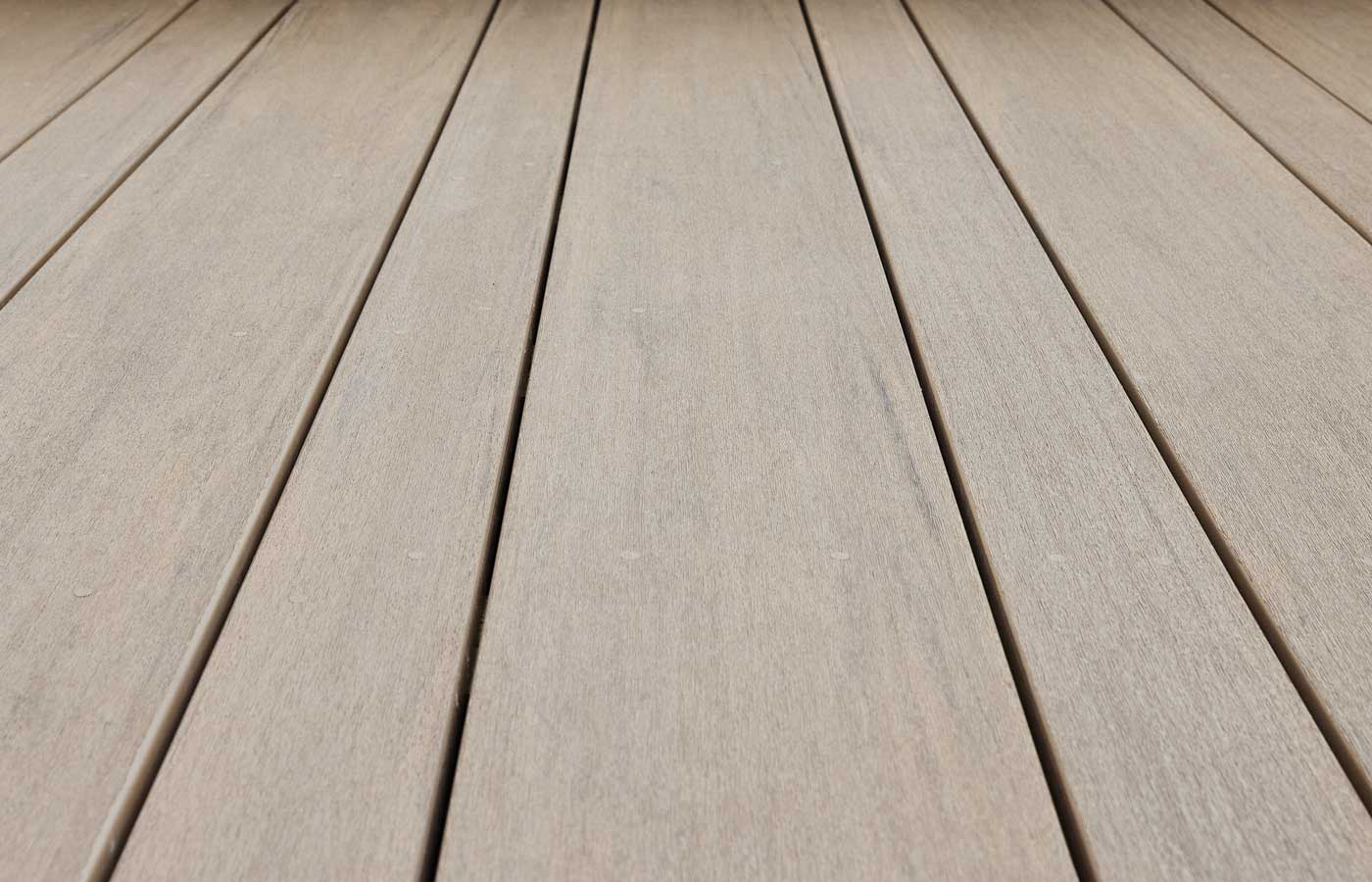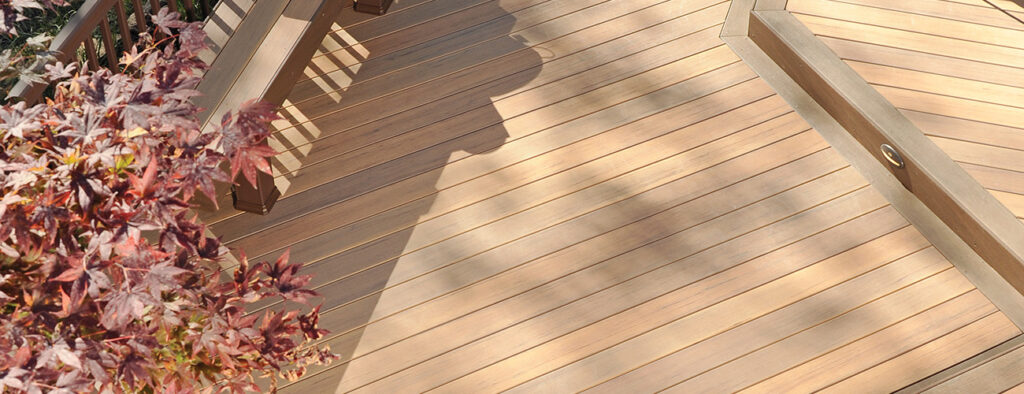If you own a wood deck, you probably dread cleaning it before family gatherings or a barbecue. On the contrary, if you have a composite deck, you probably don’t even bat an eye about cleaning — because these materials are so low-maintenance, you might only need to do a quick sweep to get it looking good.
Composite decks are engineered to last longer with fewer maintenance requirements. But, as with all finer things, you still need to ensure they withstand the test of time. In other words, you need to learn how to clean composite decking the right way.
The good news is that because of their high-performance design and durable material composition, composite decks don’t need to be sanded or stained for protection, making them less expensive to maintain than wood decks. A composite deck just needs to be periodically cleaned with the right cleaning methods, cleaner, and brush — a safe and straightforward afternoon job when following our cleaning guide.
In this guide, you’ll learn how to properly clean and maintain a TimberTech composite and PVC decking in five steps:
Let’s get into it.
TimberTech Tip:
Before cleaning your deck, identify your manufacturer and follow their cleaning guidelines. Also identify the specific decking material used — whether it’s capped, uncapped, or another manufactured material like PVC — as best practices vary.
Step 1: Clear the Deck
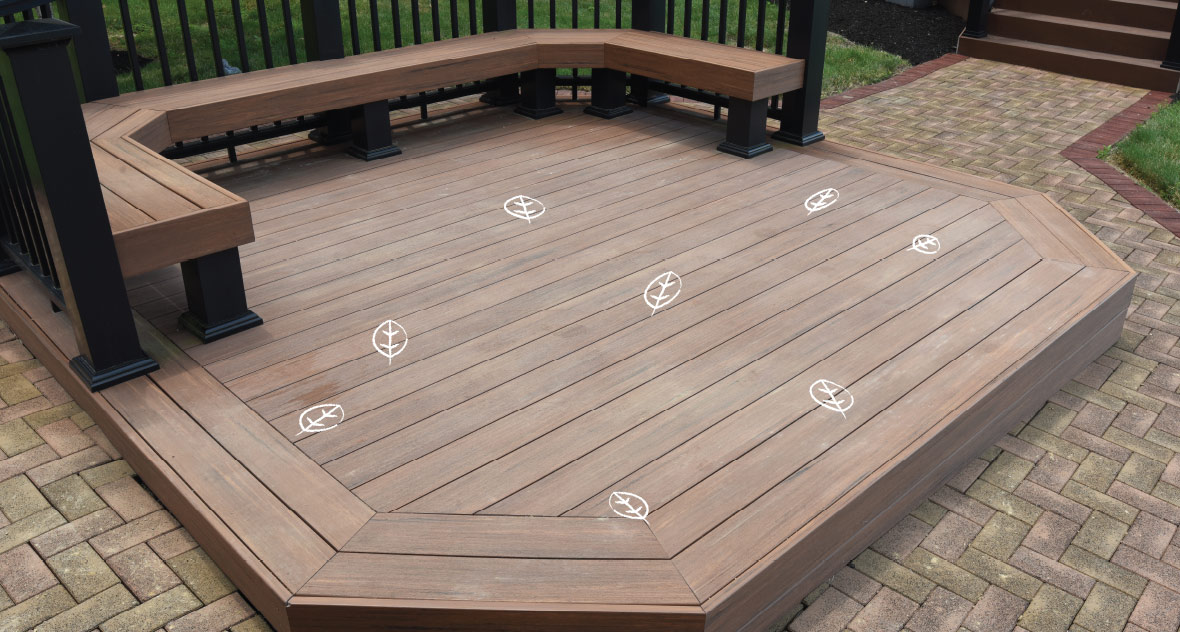
Before cleaning a TimberTech composite or PVC decking, you have to first prepare the space. Start by clearing everything, including tables, chairs, and potted plants. This ensures you’ll be able to reach every little spot on your deck. Although this process may take some time, it’s better than having to clean around your furniture.
Once the space is clear, sweep away dirt and debris and remove any leaves or branches. Don’t forget to double-check if there’s dirt that needs to be removed from the crevices or corners of your deck.
This is also a good time to cover any nearby plants, flowers, or other deck decorations that could get damaged by the cleaning process.
Step 2: Prepare the Cleaner
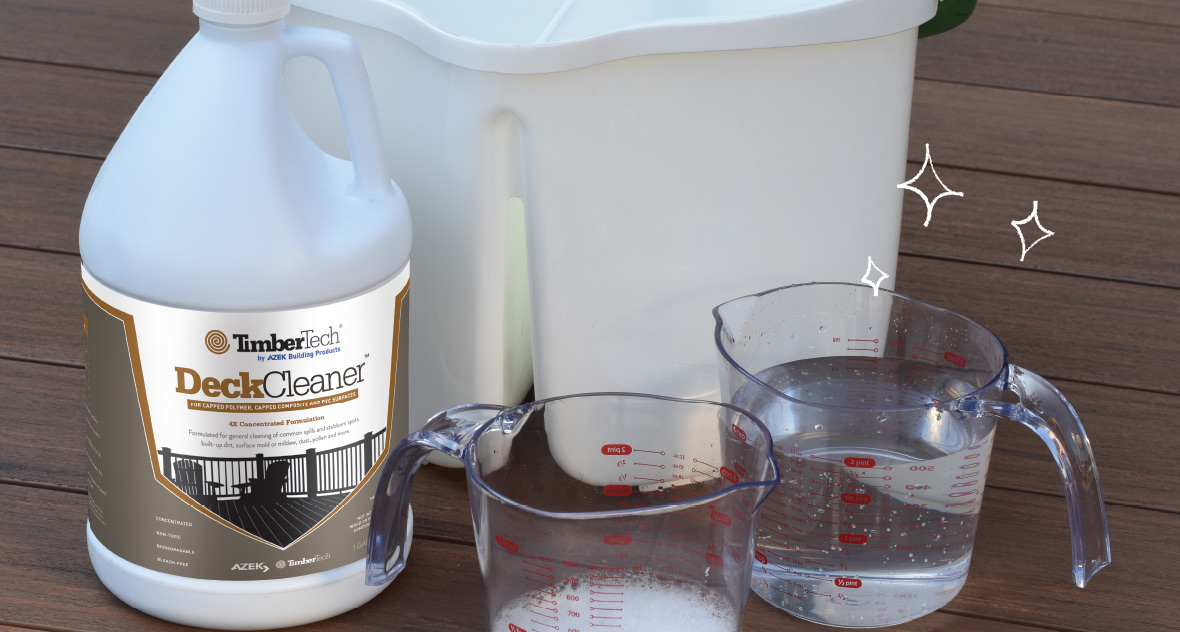
After you’ve cleared the deck, it’s time to get your manufacturer-recommended composite deck cleaner and tools ready.
For the cleaning process, you’ll need:
- A 5-gallon bucket for your cleaning solution
- A spray bottle for spot treatment of stubborn areas, if needed
- A measuring cup to measure out the cleaner
- A broom or leaf blower to remove loose debris
- Terry cloth towels, sponges, or a sponge mop for drying off standing water
- A deck brush with medium stiffness nylon bristles for TimberTech composite decking or a stiff natural fiber brush if you have a TimberTech PVC decking.
The best way to clean a composite deck is with a cleaning agent specifically designed for your deck material. If you’ll be using the TimberTech® DeckCleaner™, start by shaking it well and mixing one part cleaner to three parts water. One gallon of diluted cleaner should cover approximately 1,000 square feet of surface area.
It’s also generally safe to use mild soap, such as Wash Safe Spray and Clean Composite Deck Cleaner or Dawn dish soap and water. If you have questions, contact the manufacturer before trying any chemicals.
TimberTech Tip:
Keep all of your composite deck cleaning products and tools stored together somewhere easily accessible. This way, you’ll have everything you need handy in case of any spills or accidents.
Step 3: Section Off the Deck
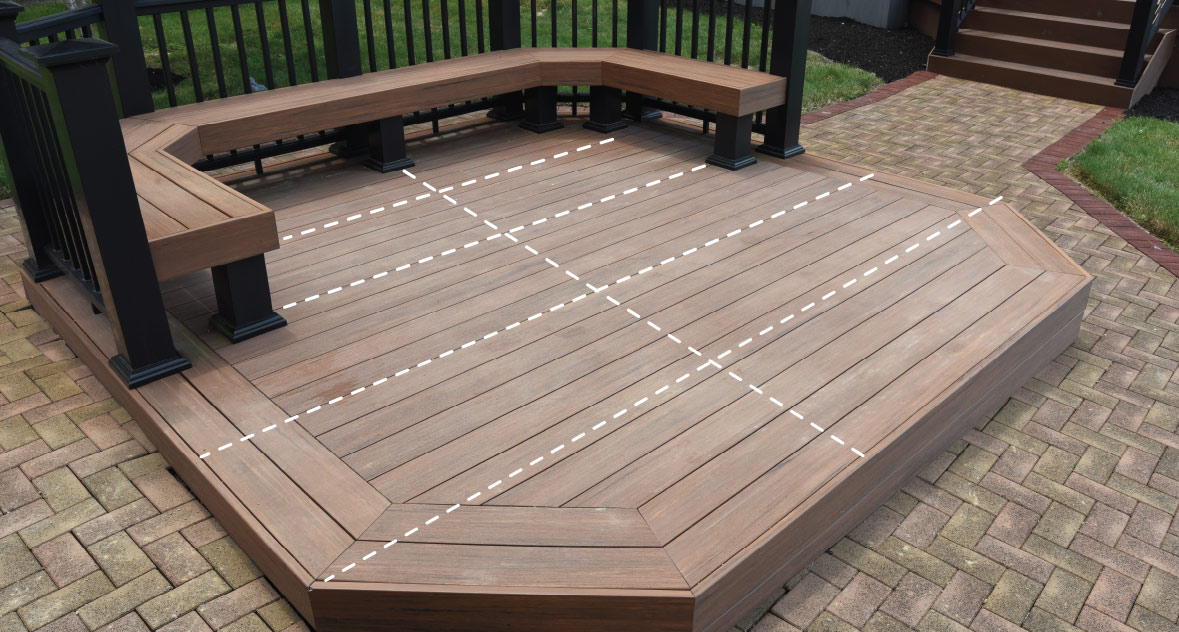
You’ve cleared the deck and prepared your cleaner. Now it’s time to map out where you’ll start cleaning the deck. We recommend cleaning your deck in small sections, working through one area at a time. This will ensure that the cleaning products won’t dry or evaporate before scrubbing.
Saturate the first area you’ll be working on with the diluted cleaner and allow it to stand on the surface for 30-60 seconds. Do not allow the cleaner to dry or evaporate before scrubbing, since it will leave a residue that is hard to remove.
TimberTech Tip:
Clean your composite decking in the morning or evening to avoid the afternoon sun, which can cause the cleaner to evaporate too quickly.
If you can’t avoid the sun, work in small sections and create shade to slow the drying process.
Step 4: Clean Your Composite Deck

Using the recommended brush for your TimberTech deck, like one with medium-stiffness nylon bristles for composite materials, and an extension handle, scrub using downward pressure. First, scrub hard in the direction of the grain and then against the grain. This will ensure that all of the dirt and debris gets removed from the surface texture of the boards. For tougher areas, you may need to scrub twice.
Pay extra attention to the corners and edges of your decks, since these areas tend to collect more dirt and debris. If needed, apply more of your cleaner or soapy water and clean it with a sponge, by scrubbing as previously described.
Step 5: Do a Final Rinse
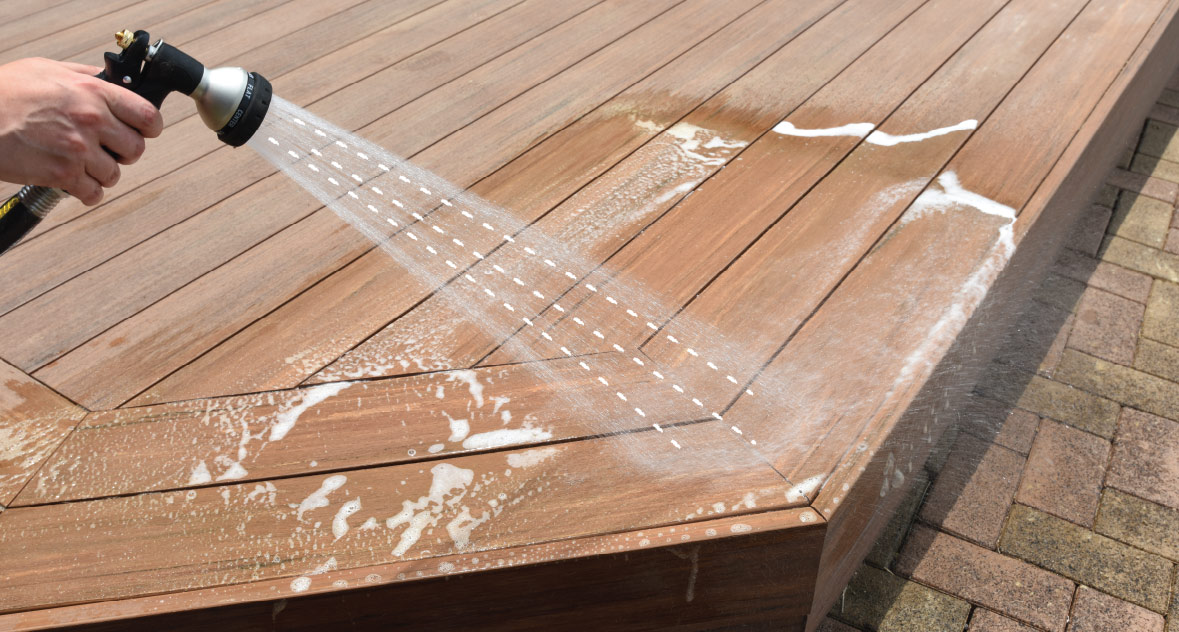
Once you’re done brushing the section you’re working on, thoroughly rinse the treated area with clean water so there’s no residue left. For best results, soak up standing water with a towel or sponge mop.
Move on to the next sections and repeat the process: apply the diluted cleaner, scrub, and rinse until your deck is fully cleaned. Then allow the deck boards to air dry completely.
By using the right brush and the correct cleaner, your deck won’t suffer from leftover residue. Instead, your deck will have a bright and clean surface, reminiscent of the day it was installed.
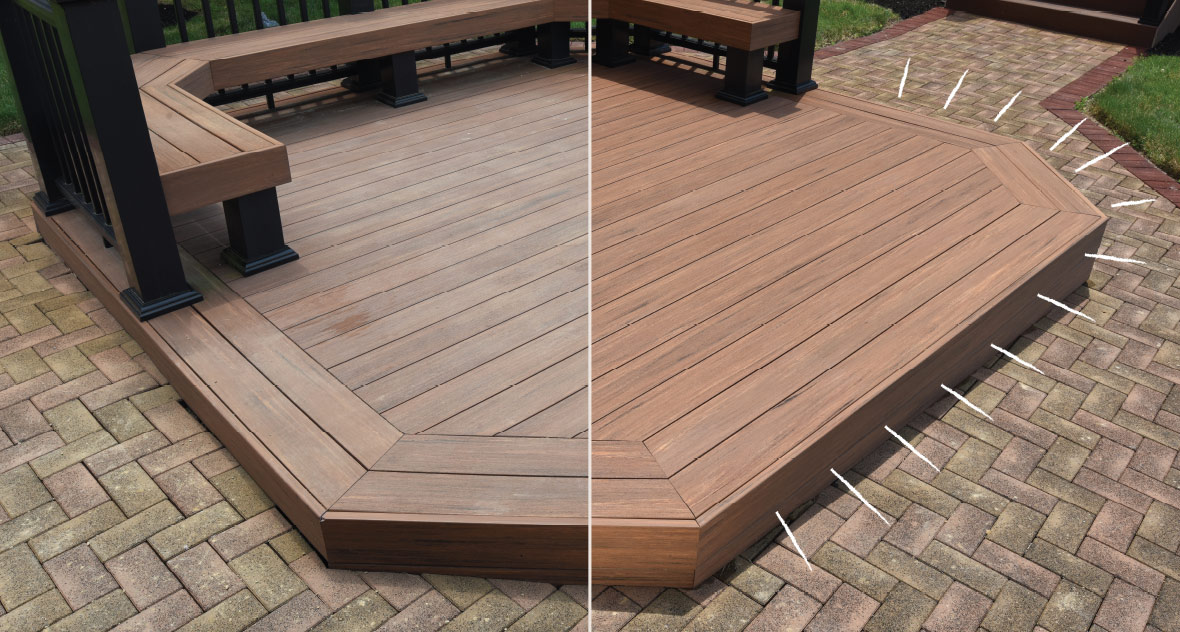
Best Cleaner for Composite Decking by Problem Type
Above all, you need a reliable cleaner for your composite decking. That begins with knowing which material your composite deck is made of — and what needs to be removed from it — so it can be cleaned properly.
For overall cleaning and maintenance, the best cleaner for composite decking will be one specifically designed for your deck, like TimberTech® DeckCleaner™. You should also use the appropriate brush if you have a TimberTech capped composite or capped polymer (PVC) deck.
How To Keep Composite Decking Looking Like New
- Regularly sweep leaves, debris, dirt, and pollen from the surface
- Spot clean mud, paw prints, and footprints quickly
- Wipe up any spills right away
- Remove mold and mildew as it appears to prevent it from spreading
- Protect your deck with covers when working with cement, mortar, or paint
But depending on the type of spill or stain on your deck, you may also use other mild cleaning agents to tackle specific issues like mold, mildew, and rust. However, other factors — such as how long the mess has been there — may affect how to clean composite decking.
Before treating issues like this, make sure any cleaning product is safe to use on your composite deck material by checking with the manufacturer’s guidelines for proper cleaning recommendations.
Here’s how to clean composite decking by problem type:
| How To Clean Composite Decking: Common Issues | |
|---|---|
| Stains | Wipe away spills as soon as possible with a dry paper towel. Use a cleaning agent and water or TimberTech® DeckCleaner™ for spot cleaning and tough-to-remove stains. |
| Snow and ice | Remove snow and ice from your deck with a plastic shovel. Do not use metal-tipped shovels, as they can damage your deck surface. |
| Mold and mildew | Rinse the affected area with a cleaning agent and water, and use a deck brush with medium-stiffness nylon bristles to remove the mold or mildew. |
| Oil and grease | Remove all oil and grease with a paper towel as soon as possible to prevent staining. Then clean any residue with a cleaning agent and water. |
| Dirt and debris | Sweep dirt and debris and spray the area with a hose to remove it. Do this regularly to prevent mold. |
| Hard water stains | Clean the affected areas with white vinegar and rinse with filtered water or dry it with a cloth. |
| Tannins | Sweep away debris then clean it with a deck cleaner. Tannins will usually weather away in a couple of weeks. |
If you’re still having trouble cleaning your wood deck, consider upgrading to TimberTech composite decking. And with our guide on how to clean composite decking, your deck will be sparkly clean for your next family get-together in no time.
Start your deck project by contacting a TimberTech expert with any questions, then order free samples of TimberTech decking to see the real-wood look of the boards and feel their durable, high-performance materials for yourself.
How To Clean Composite Decking FAQs
If you still have questions on how to clean composite decking, here are answers to some commonly asked questions.
What Are Composite Decks Easier To Clean?
Composite decks are easier to clean because they are engineered for lower maintenance. This is due to the fully engineered capping that helps lock moisture out, and the all-weather material resists staining and fading.
Can You Use Dish Soap To Clean Composite Decking?
Yes, you can use dish soap to clean composite decking, but you should dilute it in warm water first. However, the best cleaners for TimberTech’s composite decking are from our brand.
Can You Power Wash Composite Decking?
Yes, you can power wash composite decking but only for rinsing purposes (no soap involved). To avoid damaging the material, the pressure should be no more than 1,500 PSI. Keep in mind that pressure washing won’t clean your deck completely.
What Is The Best Thing To Clean Composite Decking With?
The best thing to clean composite decking with is a proper brushes and deck cleaner, like TimberTech® Deck Cleaner™.
How Often Do I Need To Clean Composite Decking?
We recommend a full-scale cleaning of your composite deck at least twice a year, and when temperatures are above 55 ℉ . Typically, it’s best to clean your deck at the transition of seasons, like from winter to spring and summer to fall.
You should also clean your deck after it has been exposed to extreme weather or after any standing moisture or other natural material has sat on it (think sand, dirt, mud, snow, or sleet). This will help prevent damage and discoloration.
After you’ve completed a thorough cleaning of your deck, you can implement a simple upkeep routine for a quicker cleaning process in the future. Remember to contact the manufacturer before trying any chemicals or cleaners on your decking.


